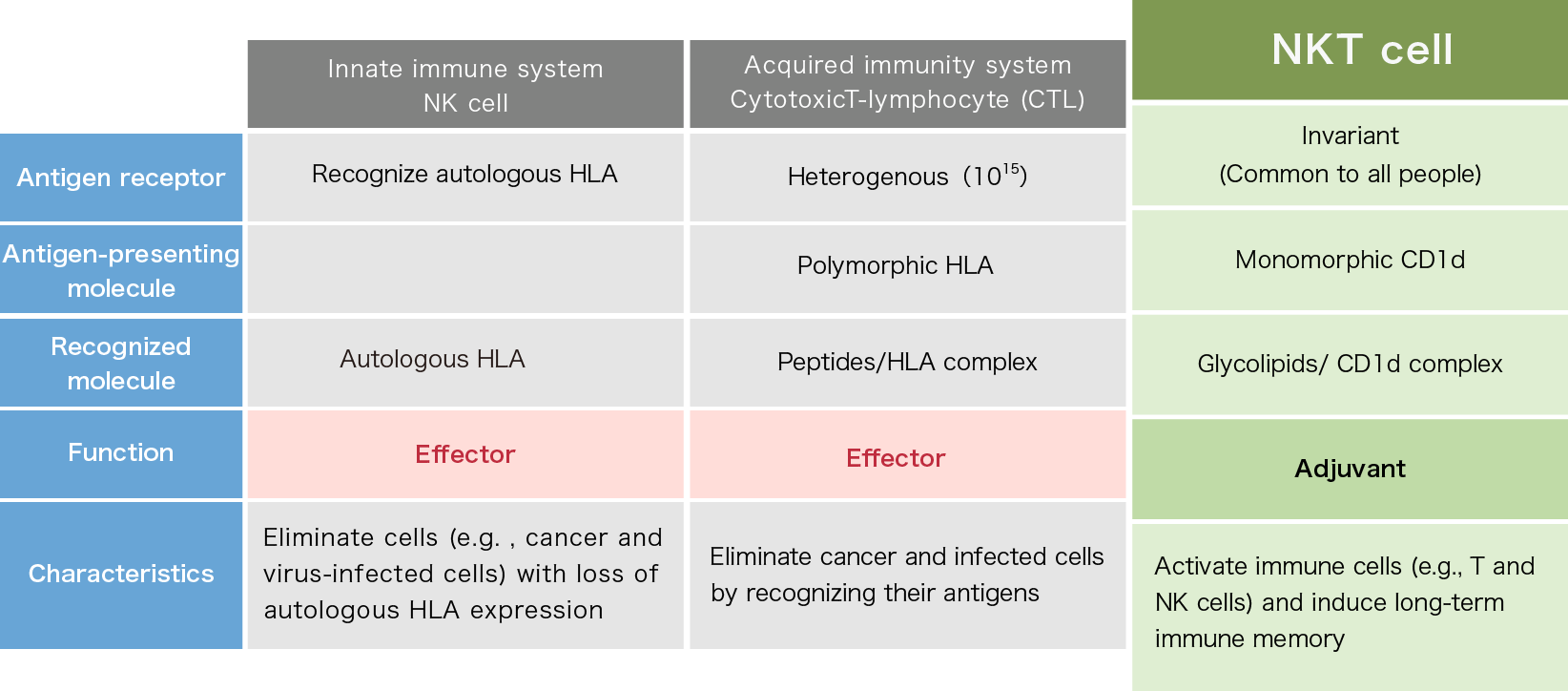Natural Killer T (NKT) Cells
Natural Killer T (NKT) cells are unique T cells that combines the properties of NK cells.
NKT cells were
first discovered in 1986 by Dr. Masaru Taniguchi (currently Senior Visiting Scientist, RIKEN Cluster for
Science, Technology and Innovation Hub ) et al., and are known as the fourth lymphocyte following T, B cells,
and NK cells. NKT cells account for around half of the T cells found in the liver and in bone marrow.
NKT cells are activated promptly when glycolipid antigens are recognized. Multi-type cytokines are produced upon this activation, inducing both immune-stimulation and -suppression. Currently, researchers are using various glycolipid NKT ligands to look into the structure-activity relationships that selectively induce immune responses.
A defining feature of NKT cells is that they involve the expression of only one type of T-cell receptor (TCR), with little in the way of diversity. Furthermore, while the regular T-cell receptor recognizes peptides presented in major histocompatibility complex molecules (MHC molecules) as antigens, the T-cell receptor for NKT cells is unique in that it recognizes glycolipids presented in CD1d molecules as antigens as well, covering for the gap left in antigens recognized by regular T cells.

How NKT cells work
NKT cells induce cell death in cancer cells in the similar mechanism with NK cells, but their direct cytotoxic activity is limited because they are only found in small quantities in the body. However, NKT cells do have the ability to produce large amounts of cytokine (IFN-γ, etc.).
NKT cells contribute to the activate NK cells and other cells representing innate immune system and cytotoxic T cells(cytotoxic T lymphocyte: CTL) representing acquired immune system through production of IFN-γ and other helper T (Th) 1 cytokines; stimulate antibody production from B cell and induction of allergic inflammation through production of IL-4 and other Th2 cytokines; and inhibit non-allergic diseases through IL-17 production.
As around 90% of NKT cells work to prevent infections, and due to the ability of NKT cells to immediately produce large amounts of cytokine upon antigen recognition without the need for clonal growth, NKT cells are currently considered to play the role of an adjuvant that activates NK cells, T cells, and B cells.
Clinical researches into cancer treatments targeting NKT cells were conducted at Chiba University. Based on the results that the treatment extended survival time of patients, the NKT cell-targeted cancer therapies have been approved as type B advanced medical treatments by the Ministry of Health, Labour and Welfare (MHLW). These include treatments applied to advanced lung cancer (2012), head and neck cancer (2013), and post-operative lung cancer (2014).
CD1d forms complex with NKT ligands (glycolipids)
CD1 is a membrane protein found on dendritic cells, B cells, monocytes and other antigen-presenting cells that present non-peptidic antigen. Of these, CD1d can present glycolipids to NKT cells. CD1d is the only one of its kind that forms complex with glycolipids, both natural and unnatural, to present them.
For example, alpha-galactosylceramide, extracted and separated from Agelas mauritianus (a type of sea sponge native to Okinawa), is known as a glycolipid that binds to CD1d on surface of antigen-presenting cells and then strongly activates NKT cells.
T cell receptor for NKT cells (NKT-TCR)
NKT cells recognize glycolipids presented by CD1d molecules. NKT cells are generally divided into two groups by receptor (NKT-TCR). NKT cells that express a TCR with a uniform variable component known as Va24Ja18 are referred to as Type I NKT cells, and others are referred to as Type II NKT Cells. Type I NKT cells account for majority of NKT cells, and because no diversity is found in NKT cell TCRs, Type I NKT cells are sometimes referred to as invariant NKT (iNKT) cells.

